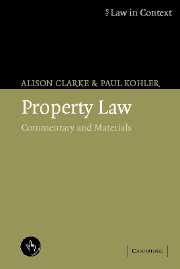Book contents
- Frontmatter
- Contents
- Preface
- Acknowledgments
- Table of cases
- Table of statutes
- Table of statutory instruments
- Table of treaties
- Table of EC legislation
- Part 1 The concept of property
- Part 2 The nature of proprietary interests
- 5 Personal and proprietary interests
- 6 Ownership
- 7 Possession
- 8 Fragmentation of ownership
- 9 Recognition of new property interests
- Part 3 The acquisition and disposition of property interests
- Part 4 Proprietary relationships
- Bibliography
- Index
8 - Fragmentation of ownership
Published online by Cambridge University Press: 05 June 2012
- Frontmatter
- Contents
- Preface
- Acknowledgments
- Table of cases
- Table of statutes
- Table of statutory instruments
- Table of treaties
- Table of EC legislation
- Part 1 The concept of property
- Part 2 The nature of proprietary interests
- 5 Personal and proprietary interests
- 6 Ownership
- 7 Possession
- 8 Fragmentation of ownership
- 9 Recognition of new property interests
- Part 3 The acquisition and disposition of property interests
- Part 4 Proprietary relationships
- Bibliography
- Index
Summary
Introduction
One of the distinctive features of English property law is that it can accommodate a wide range of property interests subsisting in the same thing at the same time, each held by a different person. As we pointed out in Chapter 6, in our system property is not synonymous with ownership. The rights and obligations which Honoré described as the attributes of ‘the full liberal concept of ownership’ need not all be held by the same person at the same time. They may be shared between and distributed among any number of different people in a number of different ways.
However, this fragmentation of ownership is highly systematised. While an owner can by contract give any person a personal right to exercise any of his ownership-type rights and obligations in any way, for any purpose and for any length of time, there are only strictly limited ways in which ownership-type rights can be subdivided and redistributed so as to leave each right holder or group of holders with a distinct property interest, as opposed to merely personal rights against the grantor. This results in a formalised structure of interdependent property interests, which is what we will be examining in this chapter. In Chapter 9, we then look at the gateways to this structure by considering why it is regulated in the way that it is – i.e. why we limit the range of property interests recognised in our system in the way that we do – and when and how the structure can be modified so as to give proprietary status to novel rights, or to novel regroupings of established rights.
- Type
- Chapter
- Information
- Property LawCommentary and Materials, pp. 297 - 344Publisher: Cambridge University PressPrint publication year: 2005



